Augmenting Perception: An Interview with media artist, Refik Anadol
by Alexandra Gilliams
Refik Anadol is a Turkish-American media artist who is broadening the possibilities of art today and in the future. Rather than paint or marble, he uses artificial intelligence and data as material to create mesmerizing visuals that he refers to as “data sculptures” and “data paintings,” as well as immersive installations. Similar to the changes in the history of art with the invention of the paint tube or photography, he is thoughtfully using new innovations to create art in the 21st century. He does so by using technology that is becoming increasingly embedded in our daily lives: computers, data, coding, and artificial intelligence. How, through AI and coding, can one arrive at visuals that look like water accompanied by hypnotic audio, and are created from marine radar data sets? He is also inspired by the idea of bringing architecture, or the world around us, into the future — what if a building had a consciousness, and could dream?
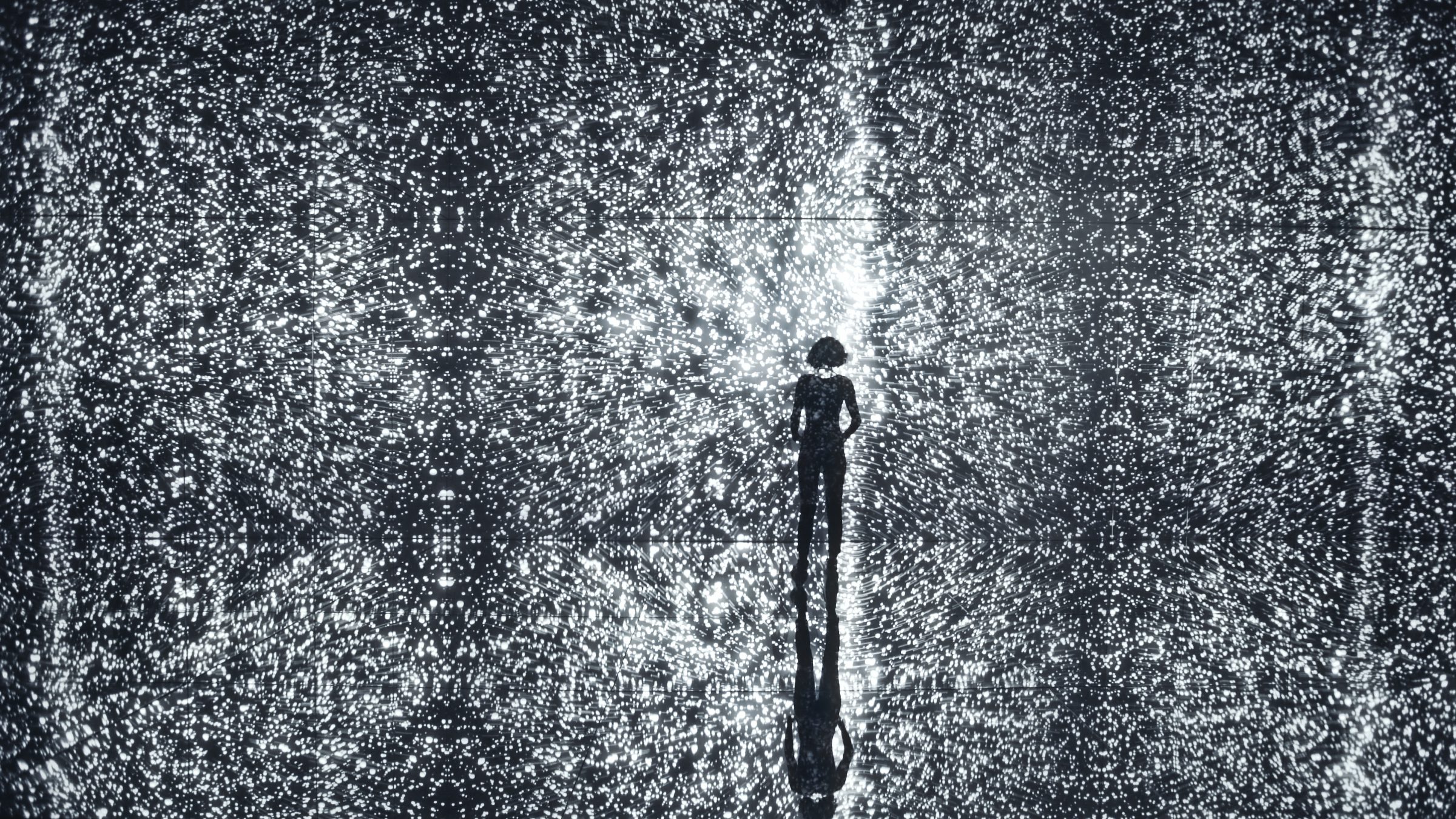
Refik Anadol,
Pladis: Data Universe,
A/V Performance, Installation Istanbul, TR
02/07/2018 – 08/10/2019 Room size: 8M x 3M x 4M Immersive Installation
3 Channel Video
5 Channel Audio
Custom Software
Media Server
Courtesy Refik Anadol StudioHe pursues these ideas with his studio: a diverse group of architects, musicians, computer programmers, and scientists that he collaborates with in order to continue widening an already large scope of possibilities for pieces. It seems as though one of Anadol’s deepest wishes is to be able to warp time and space, all while still remaining on Earth. He creates environments such as the Infinity Room, where viewers are susceptible to lose their perception of what he refers to as our “biased world”: a world wherein we are subject to gravity and other nuisances. By harnessing the invisible, such as data collected from wind or neurological data from brain scans of memories and dreams, he creates pieces that are alive, undulating and moving, and some of which evolve in real time.

Refik Anadol, Portrait
Ph: Serge HoeltschiAnadol currently resides in Los Angeles, California where he conjures up these monumental ideas with his studio. I sat down with him via Zoom to discuss the power of the imagination and his speculations for the future.
Alexandra Gilliams: I have read about how you studied communication design in Istanbul before getting your Master’s degree in design media arts at UCLA. Could you talk a bit about what led you to create the work that you are creating now?
Refik Anadol: I got my first MFA degree in Digital Communication Design and a second MFA in Design Media Arts. Within both of them, I focused on similar ideas. I started using architecture as a canvas in 2010 during my first MFA, by augmenting the perception of environments. I was using data sets from architectural drawings. In 2011, I was able to augment a three-dimensional “data sculpture.” It was almost nine years ago when I began speculating what could happen if data can become a space or, if it could become something that we can touch. I recorded sounds on the street and, using this data, I constructed a 3D surface—I call these “data sculptures”: large scale, three-dimensional augmented surfaces with light.
I have been very into architecture and speculating about the future since my childhood. I was dreaming about my room: the walls, windows, and ceiling; I was always thinking about how they were boring and static. But I was always imagining the future — what could technology bring to humanity, how could we enhance our imagination with technology? I am very inspired by science fiction as a whole. I was eight years old when I watched Blade Runner, the movie changed my life, and this movie also depicted the future of Los Angeles which is where I am currently living and working with my studio. I followed my guts and pushed the power of the imagination.
Now I am a media artist—one of the pioneers in the idea of using data as a substance—creating data paintings and sculptures and trying to find meaning behind the idea of data. I have become obsessed with data because I think it is an upcoming challenge for humanity to understand how machines communicate with each other, how machines are recording our memories, how they make meaning out of these things.
AI has been the second challenge in my career. In 2016, I was very lucky to be chosen as one of the first artists-in-residence at Google where I learned how to use AI. It was then that I created my first project with AI in a public space—a data driven library using AI called Archive Dreaming. Historically, it is an important piece because it was really the first piece that used AI and interacted with machines to understand how it learns and what happens if a machine can dream in a library. Before that, I was already using data in a public space. In 2015 and 2016, I was focused on data painting and data sculptures internationally and from 2016 to now, I am pushing the idea of AI a lot, but still using nature-focused data sets: wind patterns, temperature, air quality, but also WiFi signals, bluetooth signals, 5G LTE… I am exploring data as much as I can.
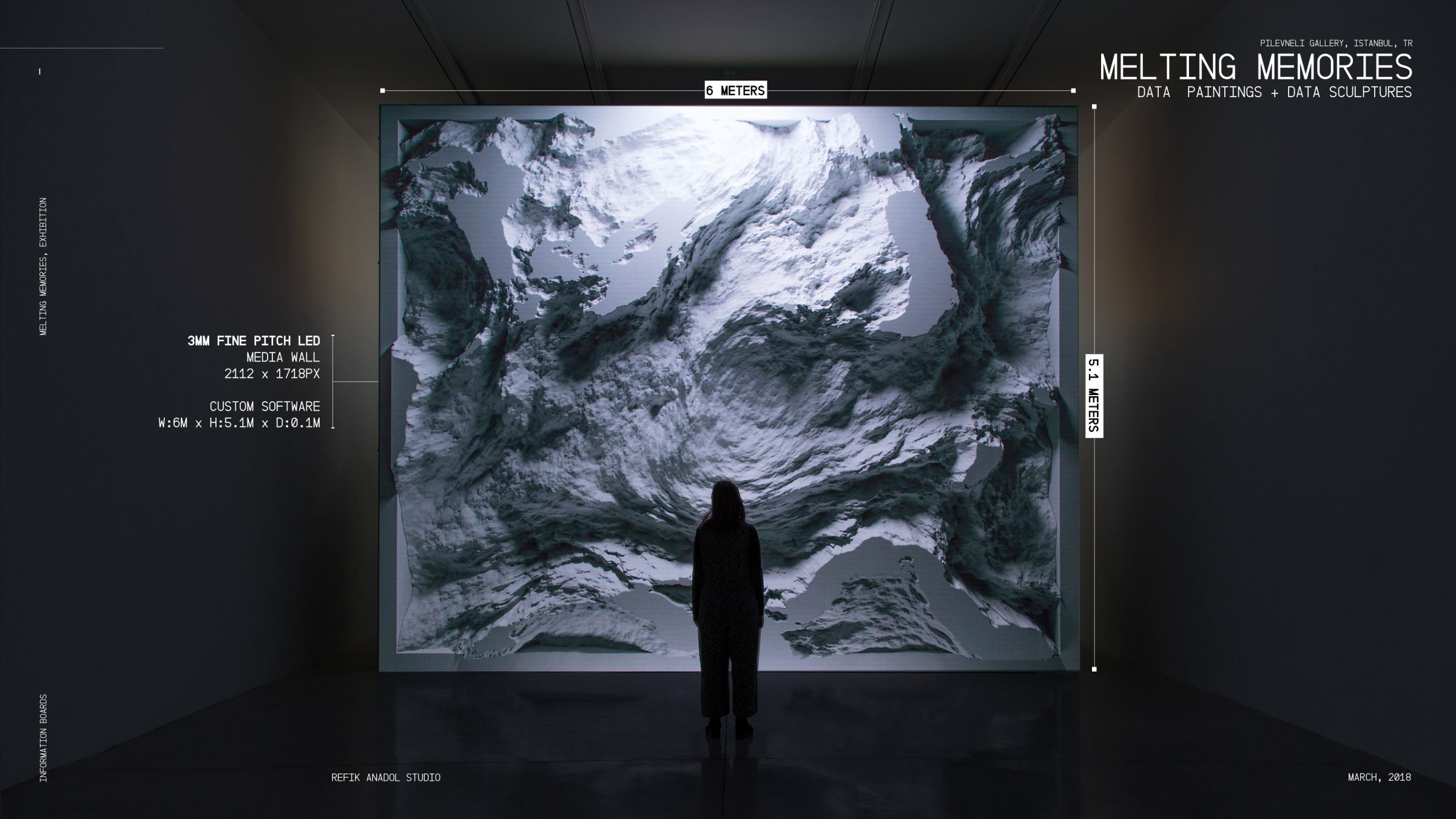
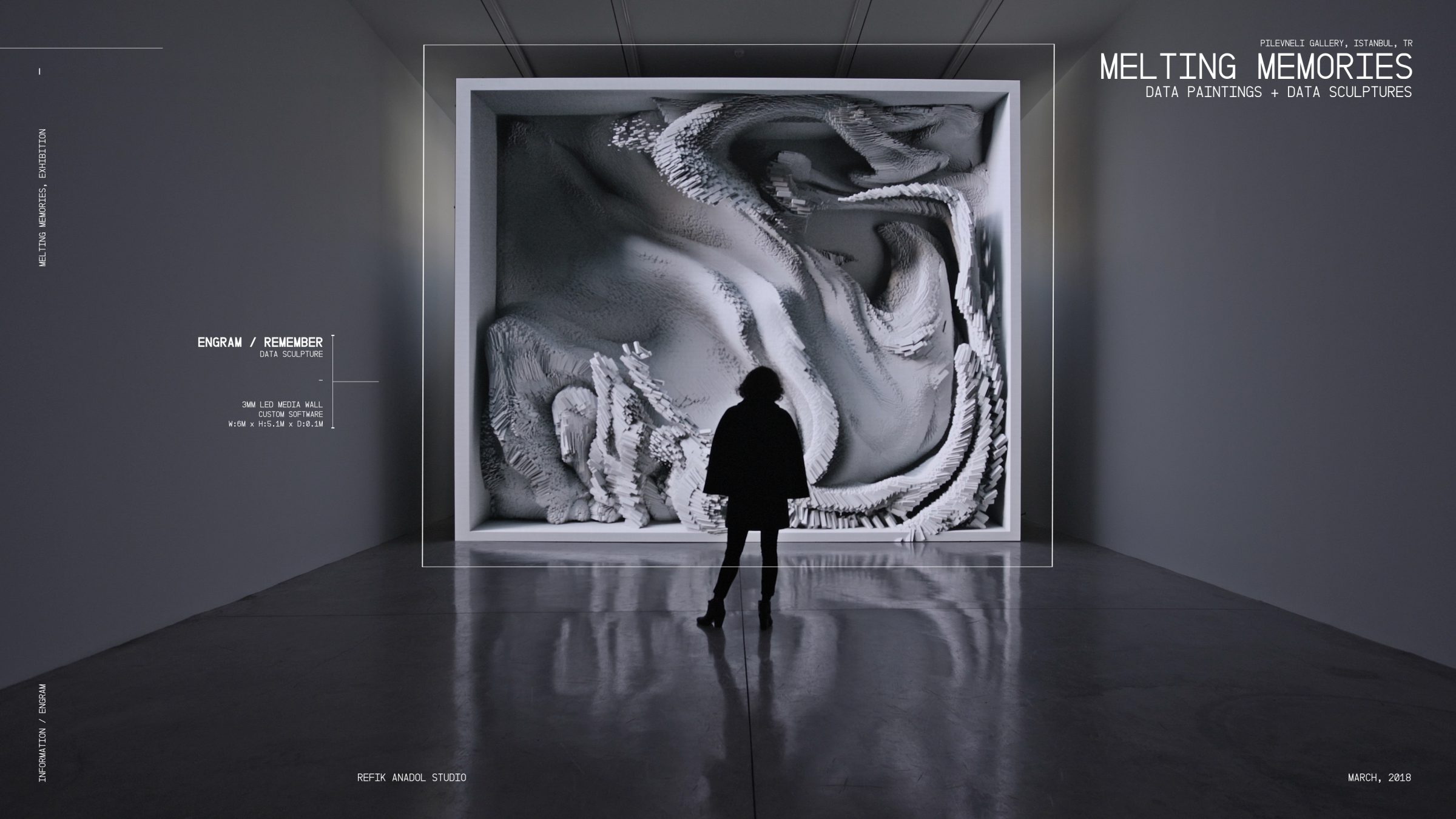
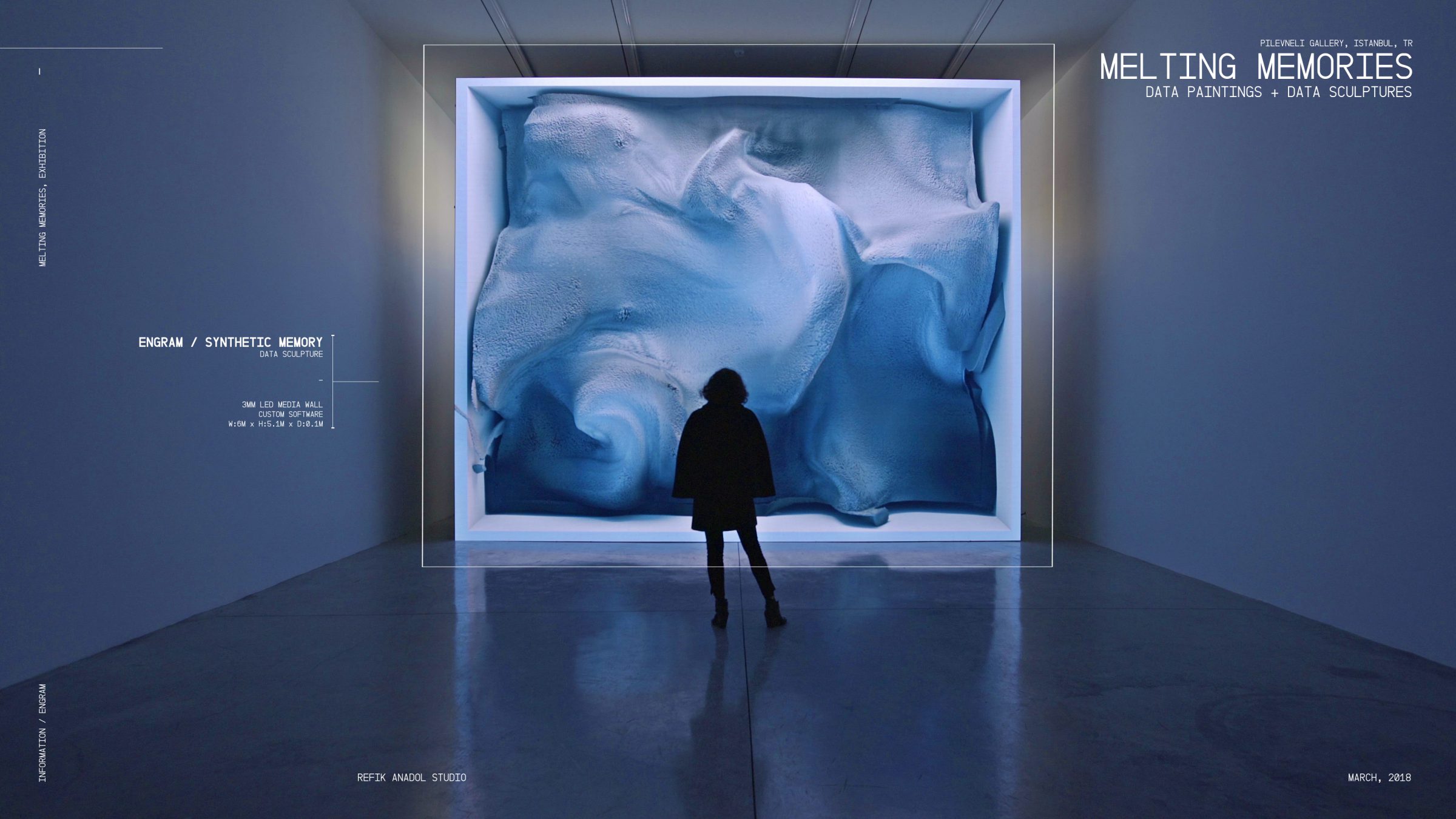
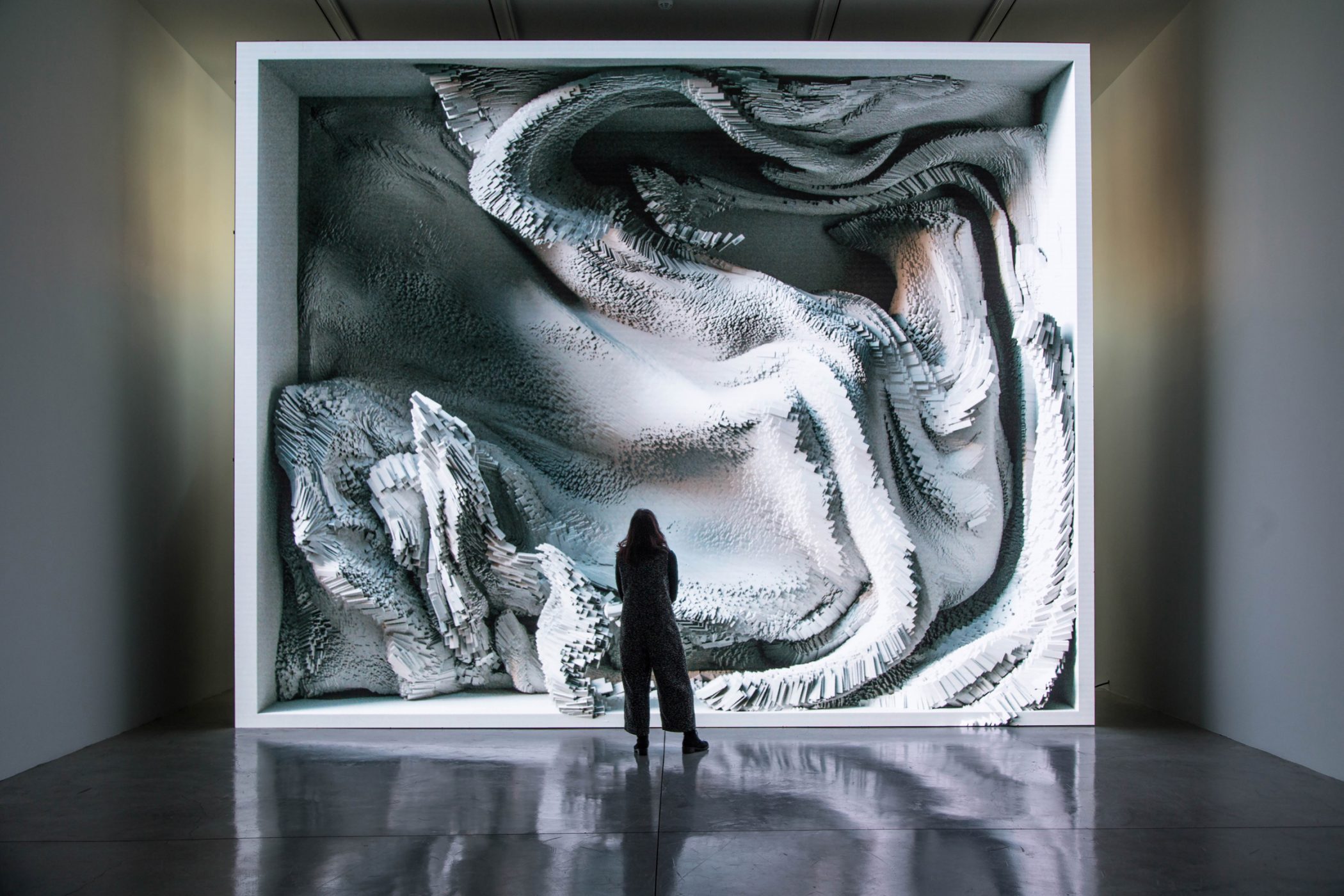
Refik Anadol, Melting Memories
Installation - Public Art
Pilevneli, Istanbul, TR 02/07/2018 – 03/17/2018 Data Sculptures
5 Meters by 6 Meters custom LED Media Wall Data Paintings
65” 4K OLED Display
Custom Software (VVVV)
CNC Milled Rigid Foam
Courtesy Refik Anadol StudioAG: In January 2019, I took a trip to Istanbul, which is where I first discovered your work. I saw your data sculpture “Bosphorus” at the Pilevneli Gallery. When I first walked into the room, I was amazed by the scale and the complex visuals undulating before me. I was absolutely fascinated by the fact that you transformed intangible marine radar data into something so physical and compelling. I am curious to know more about the kinds of narratives you follow. What does it mean to you to want to visualize the invisible – wherein you use a non-tangible source like data, and relate it to other non-tangible themes such as memories, consciousness, hallucinations, dreams, wind?
RA: First, I am very inspired by our capacity for imagination, but also the machine’s capacity for imagination and the distance between the two realities. In the end, I have humbly understood that data is information for a machine, and that making something truly meaningful with it is a large journey. For example, AI can look at the patterns of the motion of water for fifty years, and it can learn how the water moves but, you still need a human next to an AI to say “All right, I want to use this ‘thinking brush,’ this ‘brush’ that can think, and I want to paint with this brush in a way that is dynamic…” Where it can simulate life, or nature.
I am really inspired by simulations in general. In my artwork, you can see two types of algorithms: one is a noise algorithm which creates landscapes, the other is for fluid dynamics. I am extremely inspired by water, in life, and nature. So I wanted to know what would happen if an AI could learn how to move in water, and what could it create? And how would it feel, when a machine creates a sensory experience? Are we getting closer to how we might watch water in the sea? Of course not, but the attempt is in the simulation.
I am very inspired by Philip K. Dick, and in particular this quotation: “Reality is that which doesn’t go away when you stop believing in it. A simulation is that which doesn’t stop when the stories go away. Stories are responsible to our human desire for resolution, but a simulation is responsible only to its own laws and initializing conditions. A simulation has no moral, prejudice, or meaning. Like nature, it just is.”
He is my hero when I think about simulations —the Bosphorus, Black Sea, or an AI recreating nature. It is interesting to think about how machines can become our collaborators to simulate life. Why do we need that is another question. But machines are becoming more developed, they are learning fast, and the question is: “What are we doing with them?”


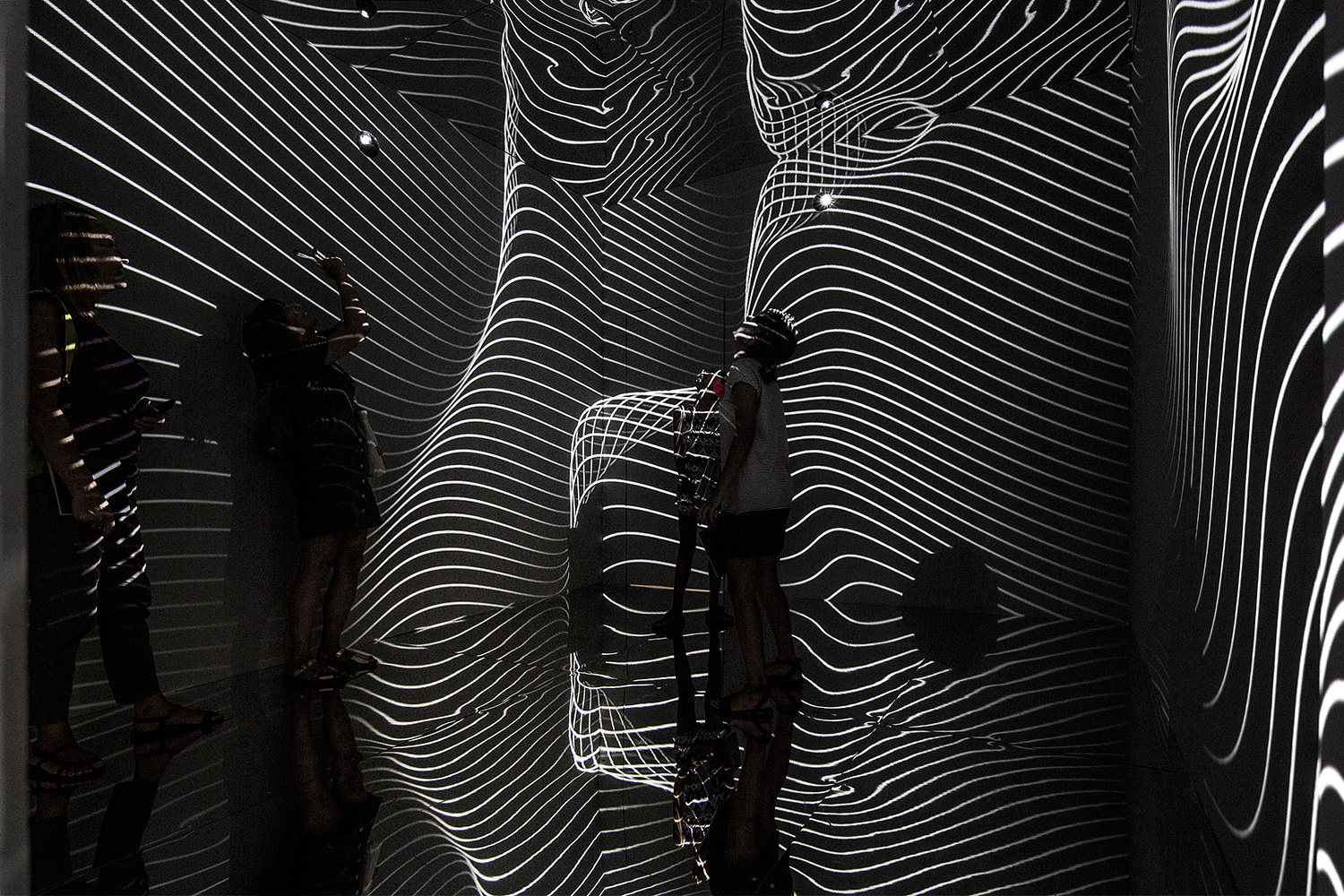
Refik Anadol,
Infinity Room / Installation - Public Art
Istanbul, TR 09/05/2015
Room size: 4M x 4M x 4M
Medium: Four channel Audio/Visual Installation running on custom software Original experience: 14 Minutes, 7 algorithms
Courtesy Refik Anadol StudioAG: With a work like “Infinity Room,” the piece is meant to “induce a state of consciousness in which the subject’s awareness of physical self is transformed by being surrounded by an all encompassing environment, creating a perception of presence in a non-physical world.” Could you elaborate on the different kinds of feelings that you hope to evoke in your viewers?
RA: I think when we use architecture and technology with a purpose, we can create feelings that become embedded in our DNA.
Everyday we use machines. We look at one first thing in the morning, and it can be the last thing we look at at night. We are surrounded by systems that know what we eat, what we say, where we go, what we buy… our free will is in the hands of machines already. What I am saying is that, in a world that is not so far off, I think we will have more inspiring experiences.
Infinity Room is an attempt to create a language that is for anyone, any age, and any background. I am very powerfully trying to find a common ground for humanity. I hate borders, I hate separating things in life — I am trying to find things that connect us, and I think if art, science, and technology are purposefully used together, we can create these experiences.
Infinity Room is also an attempt to find a super simple architectural space. You open a door, and time and space melts. Behind that door, there is no ceiling… there is no floor, corner, nor wall. In that room, a machine creates alternative realities, where you can step in and enjoy. You are removed from this “biased” world of physicality — we are based in gravity, our bodies are sagging in time and space [laughs]. But what happens if, just for a moment, we disconnect from this “biased” world. What will happen if we step into this universe that doesn’t belong to this Earth, but can exist?
This artwork travelled to 48 cities in the world on every continent, except Antarctica. I wish I could do a project in Antarctica, but not yet [laughs]. More than 2 million people explored this. I call this a “research project,” because when you have a piece that is going around the world and touching different cultures, it becomes a piece of research.
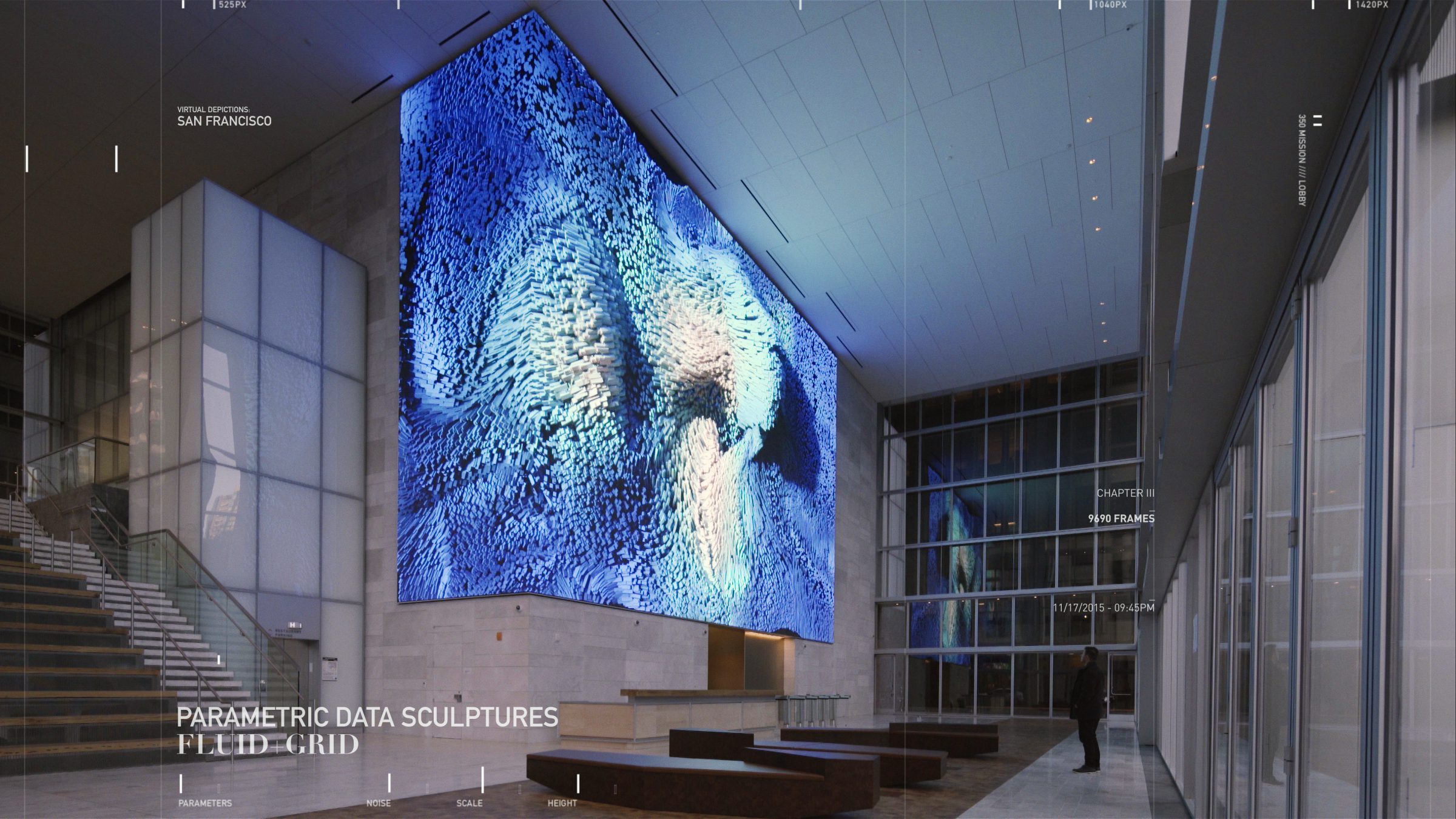
Refik Anadol, Virtual Depictions San Francisco Public Art Commissioned by Kilroy Realty Corporation, John B. Kilroy, Jr. San Francisco, US 09/30/2015 Medium: 6mm LED Media Wall Dimensions: 20′ x 40′ Custom Software (VVVV) 90 minutes long dynamic visual experience in 12 chapters 8 Channel sound Courtesy Refik Anadol StudioAG: Were you able to get feedback from your viewers on these different continents?
RA: What I understand [from exhibiting Infinity Room] is that it doesn’t matter where you are from. It doesn’t matter what your past is — your culture, your knowledge, the intellectual quality… it touched people, from what I learned.
AG: Could you tell me about “Sense of Place,” the piece in Oakland, California that recently opened?
RA: I started speculating what a place could sense, and I was inspired by research conducted by three scientists who won the 2014 Nobel Peace Prize for studying how we know where we are in space. This nature post came up, and I was so inspired by what a studio can do in a world where we are creating our own perception of space. In a world where, with neuroscience, understanding how space “melts” and how it is constructed. Sense of Place is coming from this noble research. I am speculating what machines can sense, and if can we look at it through machine algorithms. How can we see the invisible world around us?
This work uses WiFi and bluetooth signals, wind patterns, and environmental data that the building senses. One of the fundamental uses for architecture is that it is protecting us from Mother Nature. What happens if there is an artwork that draws attention to this invisible world around us? Making the invisible visible through algorithms. It is a “data painting” displayed on a wall. It is 25 x 25 feet. We have a weather station that senses the rain, humidity, temperature, wind — which are all connected to this artwork.
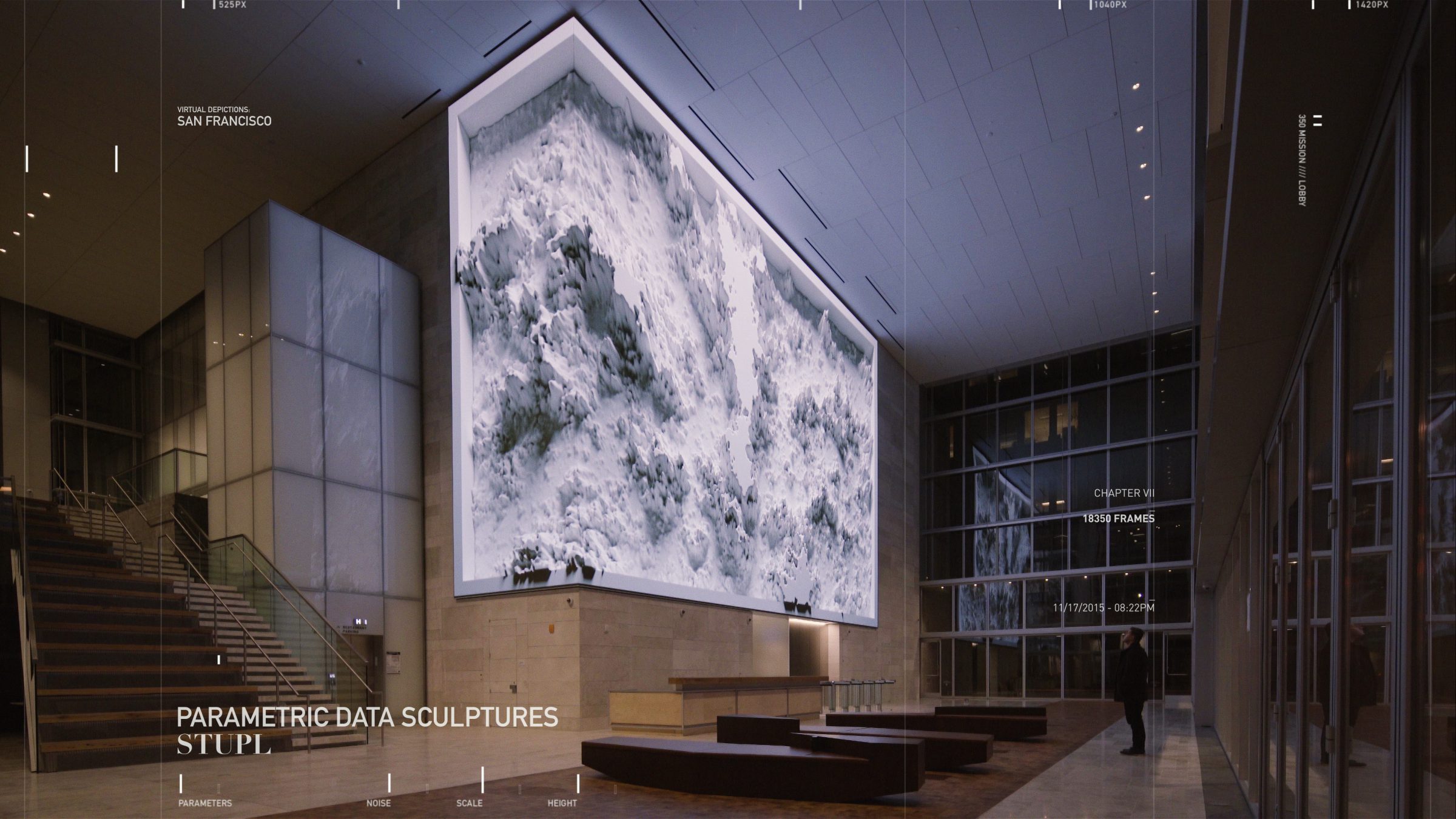
Refik Anadol, Virtual Depictions San Francisco Public Art Commissioned by Kilroy Realty Corporation, John B. Kilroy, Jr. San Francisco, US 09/30/2015 Medium: 6mm LED Media Wall Dimensions: 20′ x 40′ Custom Software (VVVV) 90 minutes long dynamic visual experience in 12 chapters 8 Channel sound Courtesy Refik Anadol Studio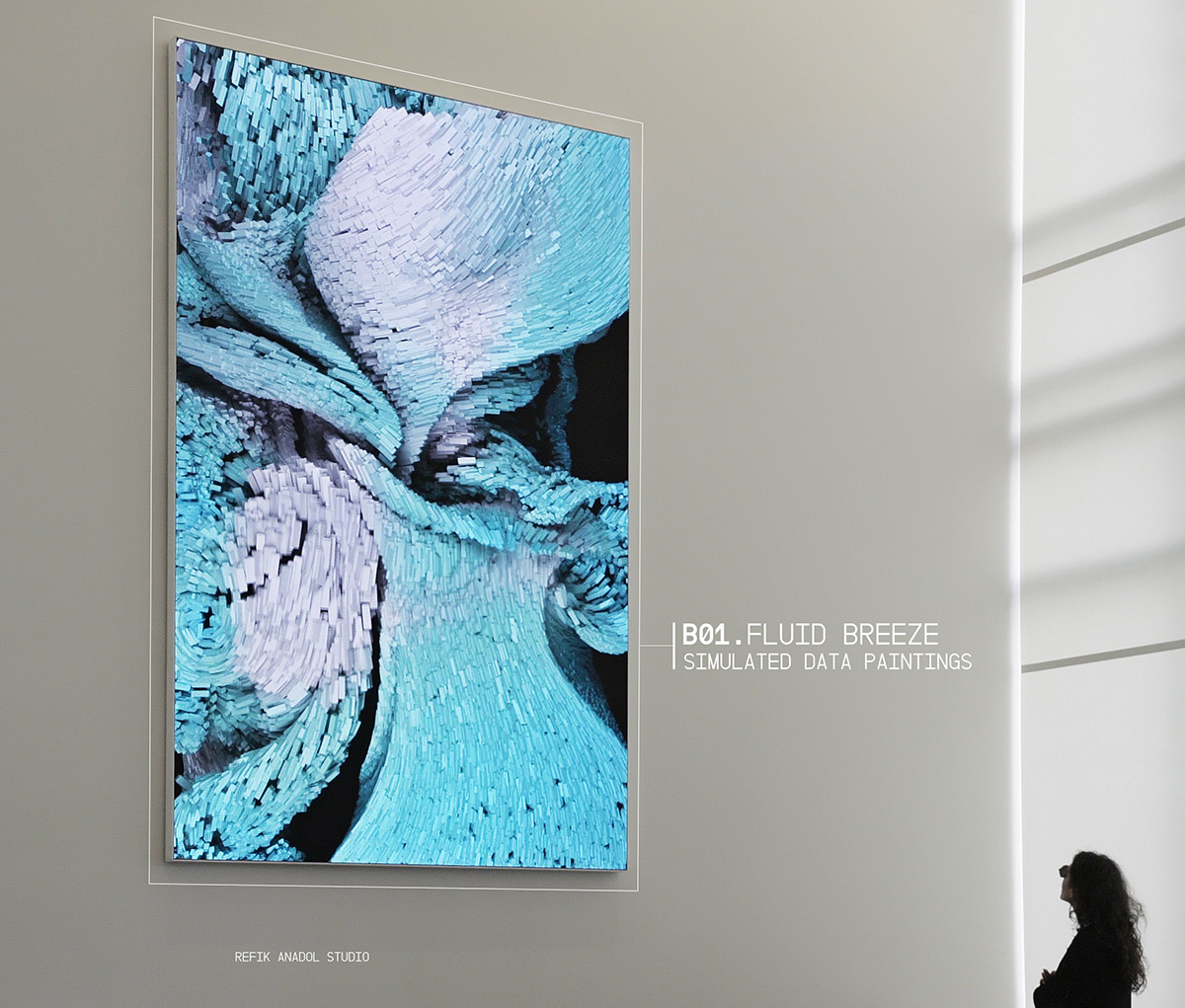
Refik Anadol, Wind of Boston Data Paintings
Installation - Public Art Commissioned By
The Fallon Company
Joseph F. Fallon
Richard Martini
Soundtrack : Goldmund / Door Of Our Home Sound Fx Design : Kerim Karaoglu
Boston, US 01/01/2017AG: I am interested to know about your process and how you create your projects with your collaborators. I imagine that it is more complex than writing a code, inputting the data, and right away you have these abstract visuals. Could you tell me a bit about how you come up with your ideas, and then develop and execute them?
RA: My last solo project was in 2011, which is when I found out how challenging it is to create a data sculpture, or a large scale piece. I found that I don’t have time to go deeper [into the artwork], so I thought about what could happen if I started a studio, where we could work on these challenges together as a collaborative imagination, like an organic machine. The dream to open a studio is one of the reasons why I joined the UCLA Media Arts department where I received my second MFA. It was my target, and I was hoping to create a project in a public space, such as Disney Hall Dreams, Frank Gehry’s project, and open it, and also work with pioneers in the field such as Casey Reas, Christian Moeller, Jennifer Steinkamp… they were my three wonderful professors at UCLA, who were my mentors, who trained me. That’s how I started, and now there are 12 people in the studio. The median age is 25, everyone can program and code. We have designers, musicians, scholars, neuroscientists, architects, machine engineers, data scientists — a very diverse group of people that can imagine together.
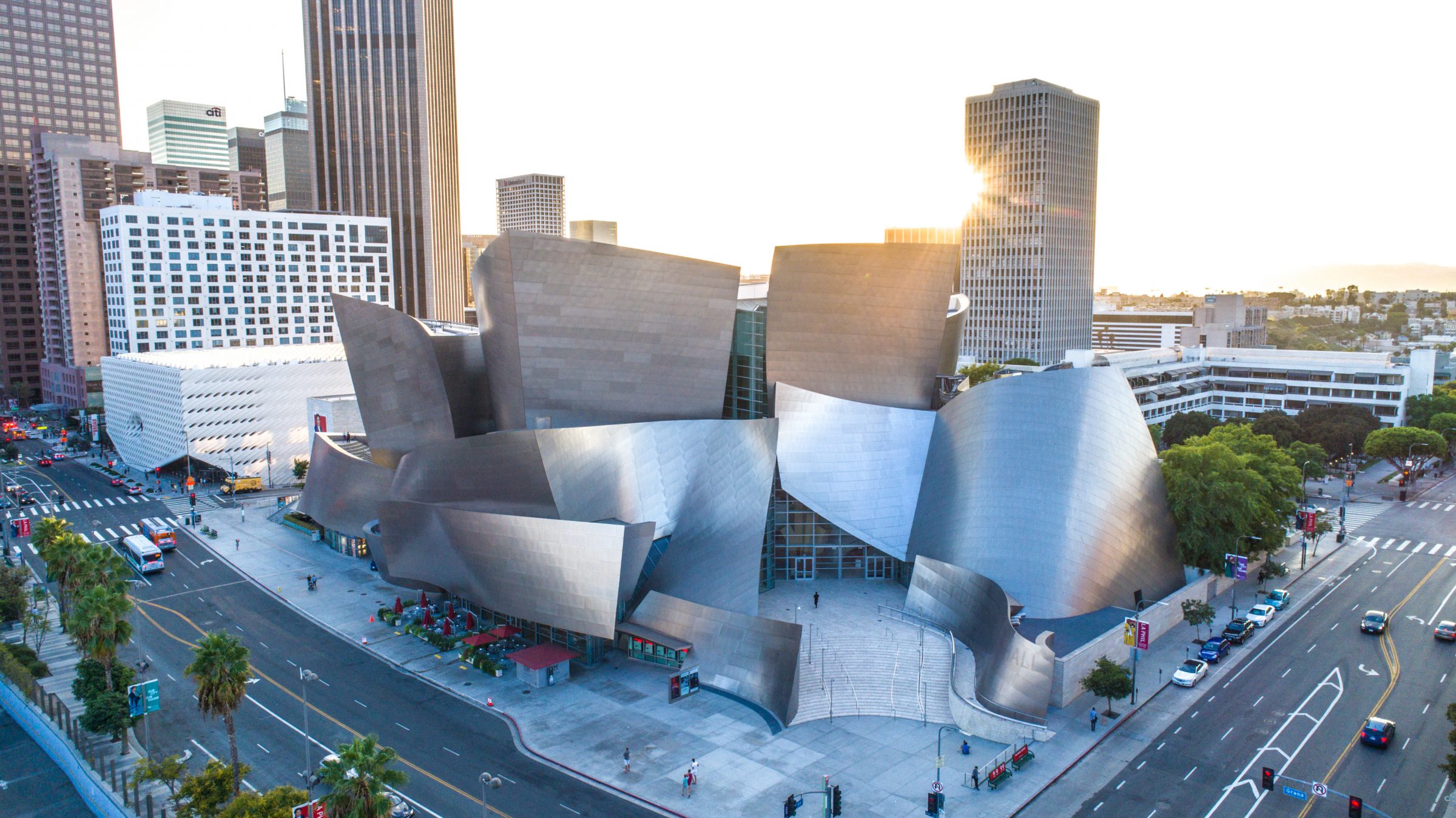
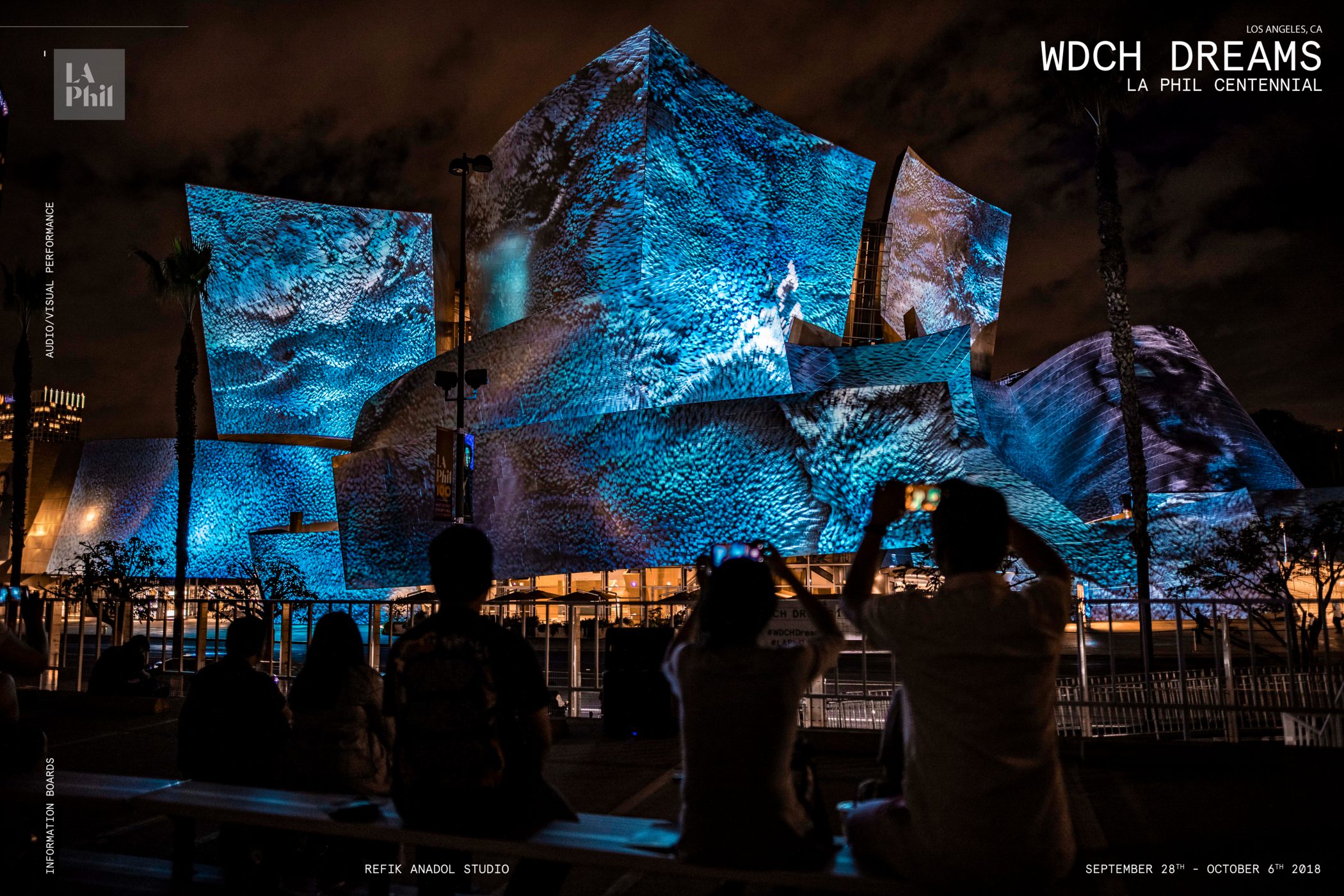
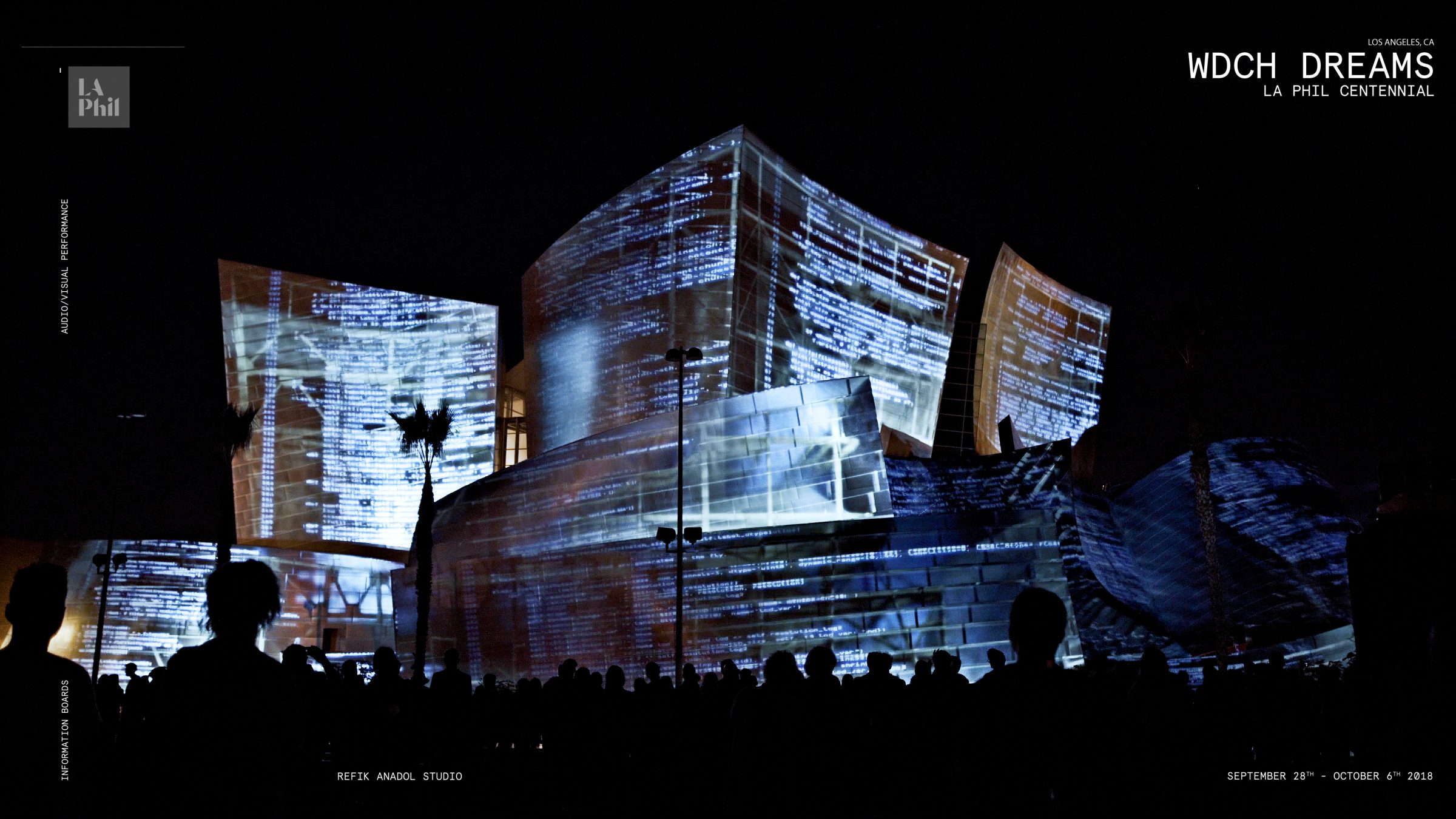
The Los Angeles Philharmonic has collaborated with media artist Refik Anadol to celebrate our history and explore our future. Using machine learning algorithms, Anadol and his team has developed a unique machine intelligence approach to the LA Phil digital archives – 45 terabytes of data. The results are stunning visualizations for WDCH Dreams, a project that is both a week-long public art installation projected onto the building’s exterior skin and a season-long immersive exhibition inside, in the Ira Gershwin Gallery
To make Walt Disney Concert Hall “dream,” Anadol utilized a creative, computerized “mind” to mimic how humans dream – by processing memories to form a new combination of images and ideas. To accomplish this, Anadol worked with the Artists and Machine Intelligence program at Google Arts and Culture and researcher Parag K. Mital to apply machine intelligence to the orchestra’s digital archives – nearly 45 terabytes of data – 587,763 image files, 1,880 video files, 1,483 metadata files, and 17,773 audio files (the equivalent of 40,000 hours of audio from 16,471 performances). The files were parsed into millions of data points that were then categorized by hundreds of attributes, by deep neural networks with the capacity to both remember the totality of the LA Phil’s “memories” and create new connections between them. This “data universe” is Anadol’s material, and machine intelligence is his artistic collaborator. Together, they create something new in image and sound by awakening the metaphorical “consciousness” of Walt Disney Concert Hall. The result is a radical visualization of the organization’s first century and an exploration of synergies between art
and technology, and architecture and institutional memory.
To actualize this vision, Anadol is employing 42 large scale projectors, with 50K visual resolution, 8-channel sound, and 1.2M luminance in total. The resulting patterns, or “data sculptures” formed by the machine’s interpretation of the archives will be displayed directly onto the undulating stainless-steel exterior of Walt Disney Concert Hall.
WDCH Dreams’ accompanying soundtrack was created from hand-picked audio from the LA Phil’s archival recordings. Sound designers Robert Thomas, and Kerim Karaoglu augmented these selections by using machine-learning algorithms to find similar performances recorded throughout the LA Phil’s history, creating a unique exploration of historic audio recordings.
Inside Walt Disney Concert Hall, in the Ira Gershwin Gallery, is an immersive and interactive companion installation, offering a unique, one-on-one experience for each gallery visitor. The exhibition presents the entire LA Phil digital archives in a non-linear fashion. The visitor, via a touchscreen interface, can interact with the archives in multiple ways: via a sunburst timeline; through curated moments highlighting milestones in the LA Phil’s 100-year history; and by delving into to the entire data universe that can be uniquely manipulated by each gallery visitor. The space will be re-imagined as a mirrored U-shaped room with two-channel projection. Visuals will be projected onto the mirrored surface giving the visitor a truly immersive, 360-degree experience.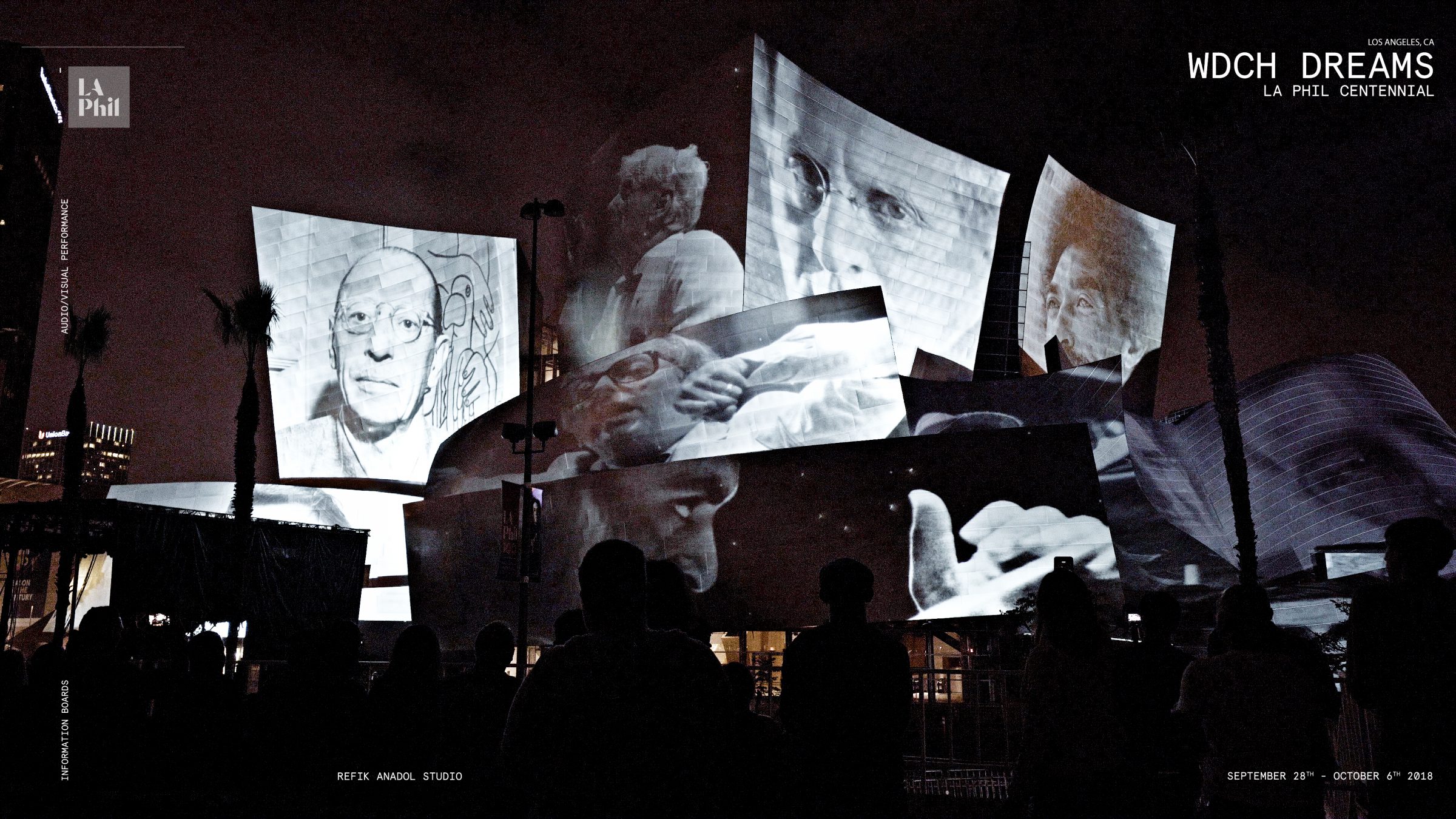
Refik Anadol, WDCH Dreams Public Art - A/V Performance Courtesy Refik Anadol StudioAG: Most of your pieces are meant to be viewed in public spaces — the Walt Disney Concert Hall in Los Angeles, for example — meaning that these works are temporarily shown. Do you consider showing these same pieces in new ways, or are your pieces meant to be ephemeral?
RA: For me, art should be [displayed] in a public space. If art is only for galleries and museums, it is old school, or boring. [laughs] Imagine one hundred years from now, we will probably be saying that humans put art in these buildings, and that you had to open a door and behind that door is art. I think that is so cheesy. In public spaces, there is no time. There is no beginning, there is no door, there is no ceiling nor floor, there is just life. Since 2009, I have never given up on public spaces.
I have made some ephemeral and some permanent pieces. In Portland, there is a printed three-dimensional sculpture, in Oakland, Las Vegas, Dubai, Seoul, London, Istanbul, New York, Chicago. We have diverse artworks that are around the world, and are permanent.
I have pieces that, using sensors, sensor the space and change in real time. I have a piece that represents frozen memories from the city of Portland, 140 years of data, recorded and frozen. Some of my pieces represent life, which is changing and complex, and some that are more about ideas that have been frozen in time… Time and space melts.
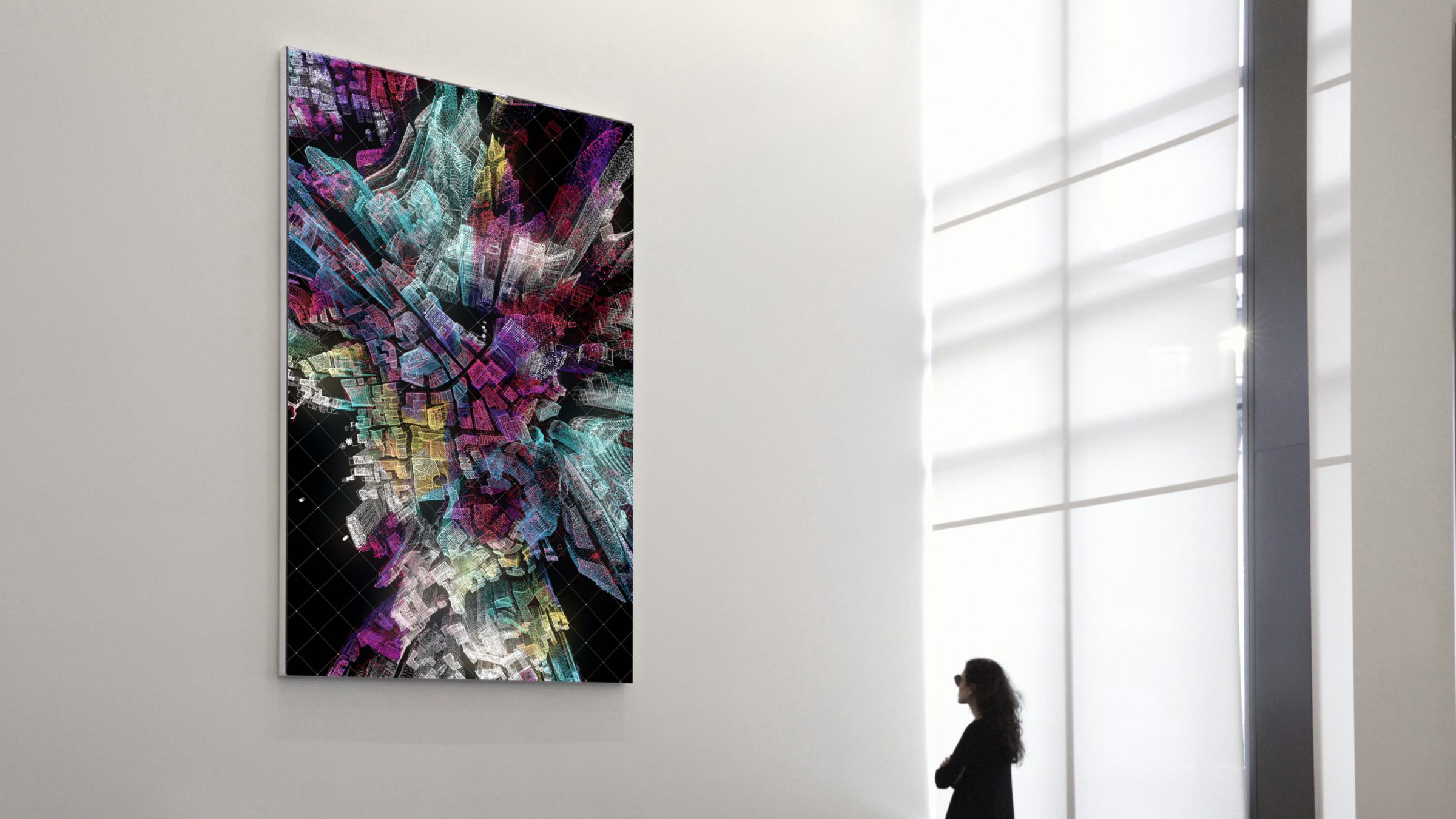
Refik Anadol, Wind of Boston Data Paintings
Installation - Public Art Commissioned By
The Fallon Company
Joseph F. Fallon
Richard Martini
Soundtrack : Goldmund / Door Of Our Home Sound Fx Design : Kerim Karaoglu
Boston, US 01/01/2017AG: During the pandemic, have you began considering making pieces in different formats, or diffusing them in a new way?
RA: Yes, and this has been challenging. Since 2016, we have been creating Machine Hallucinations and I am lucky to say that the slowing down of life during the pandemic has helped me. Life was so fast, with long to-do lists, dragging you somewhere else, to make other things…
In the studio we had been researching a lot with machine algorithms and then we decided to work with one of the largest data sets in the world of nature. We trained a neural network with 70 million photos available from around the world, and then created an AI that is dreaming of nature.
In the US especially, it was very common, at least in California, to enjoy nature, to go hiking… but during the early months of the pandemic, it was impossible; we were trapped. What will happen if AI can simulate nature for us? We are trying to recreate these experiences in life that create a similar feeling. Being in nature is incredible, but there are moments in life where you cannot go. So how can we use AI to reinterpret a world that we cannot see or touch, and get a feeling of being there?
We are also working with quantum computing since February. We are speculating with quantum mechanics. I am always playing with reality in my work, with time and space as my main materials. What will happen when quantum computing begins interfering with humanity, how can we use quantum mechanics, and what will happen to our memories and dreams? Who will define what is real? If science proves that there is an alternate reality, that there are multiple dimensions, how do we know where we are? It’s an attempt to understand this.
We are also working with the Human Connectome project, the world’s largest neuroscience database that allows you to look at the patterns of human brains and its functions. Technically there are data sets of brain scans from 4500 people, from 6 months to 105 years old, in order to understand how the brain works. We are currently collaborating with this team to unlock this data.
This project would be figurative, but also “imaginary.” What happens when we remember is Melting Memories and also what happens when we learn, what happens when we imagine, or dream? Can we catch these moments? These are “mind spaces.”
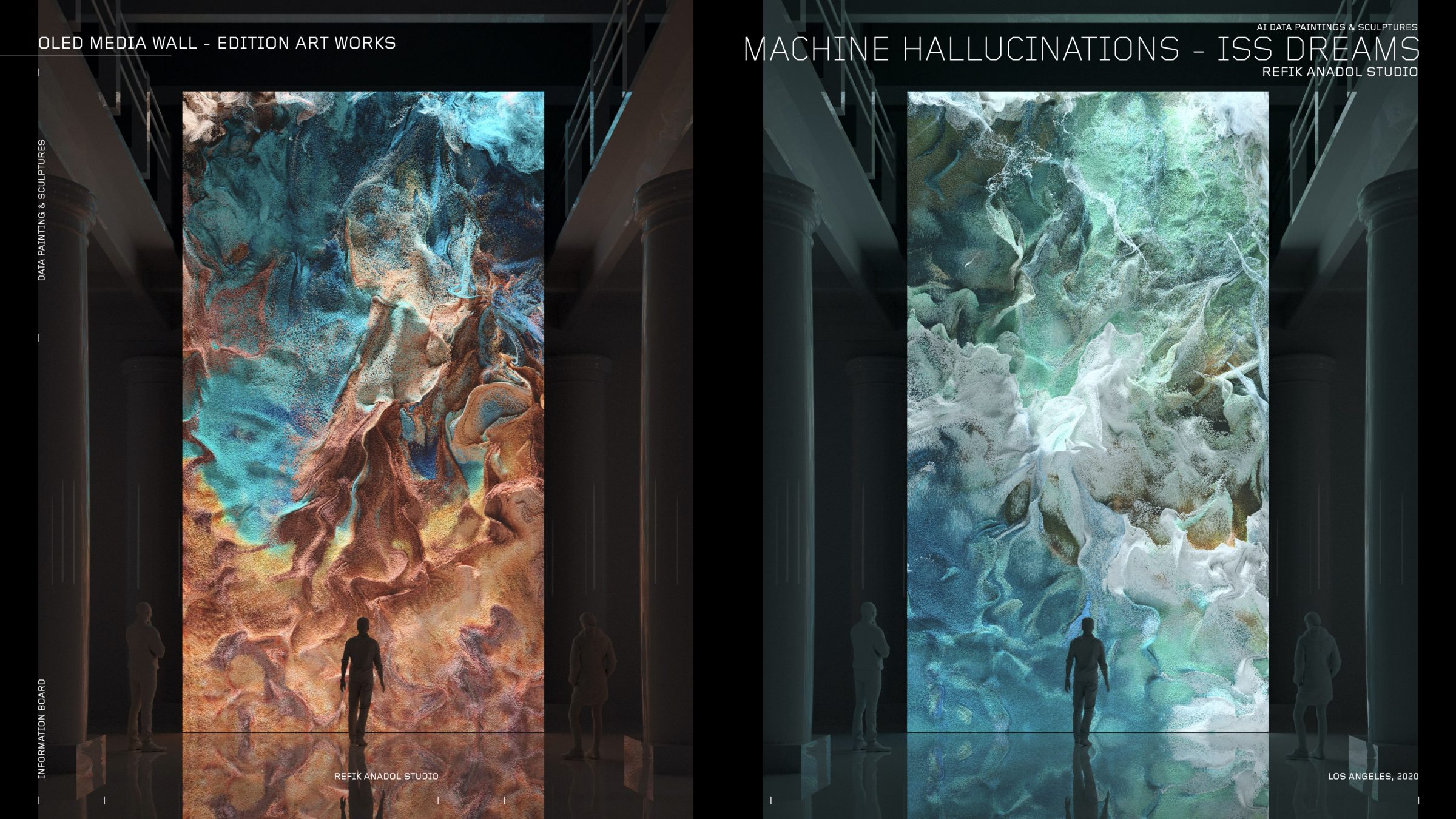
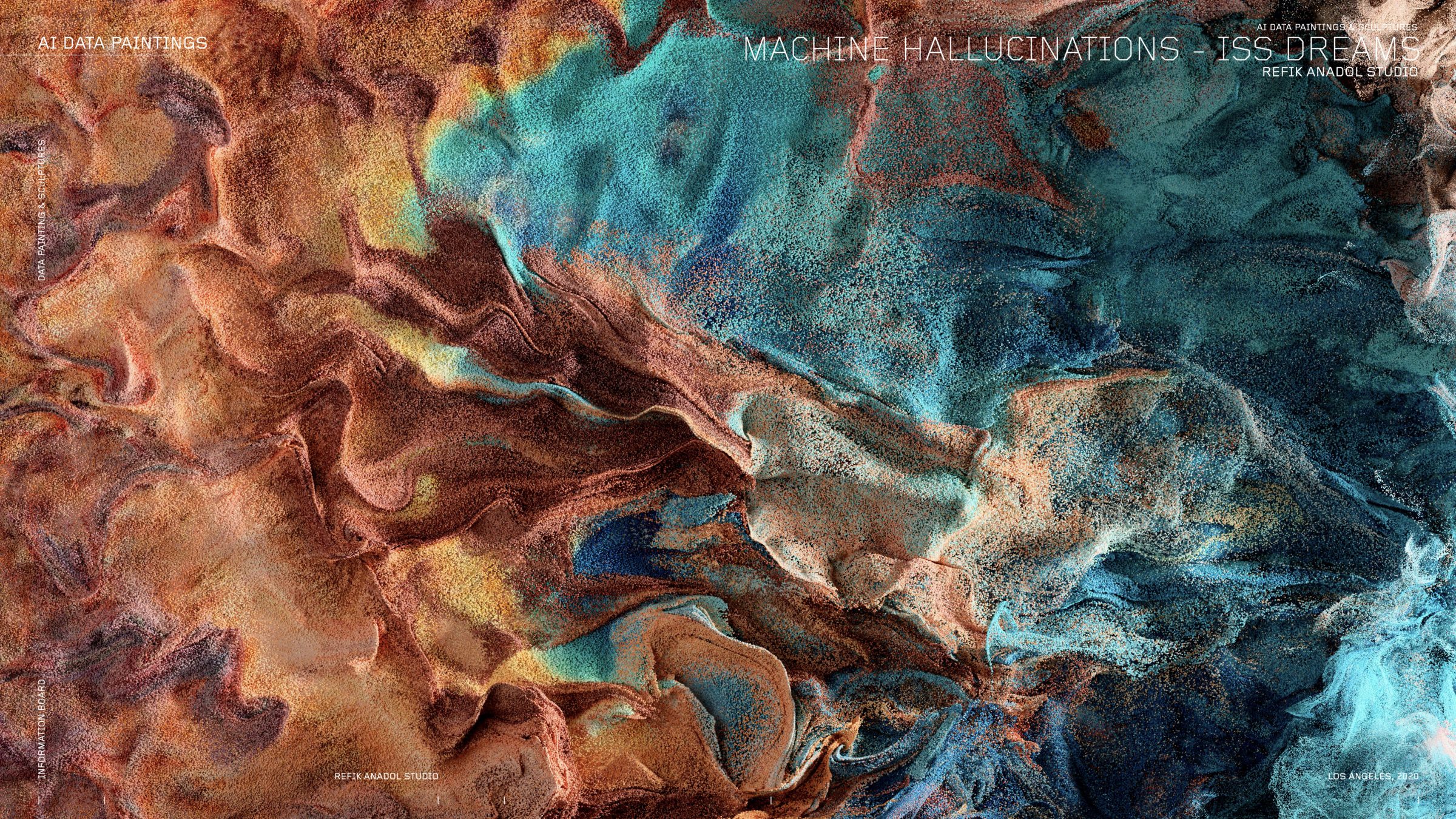
Refik Anadol, Machine Hallucinations – ISS Dreams Los Angeles, California, USA 01/06/2020 / Courtesy Refik Anadol StudioAG: You have made works in which you ask the question, “what would it be like if a machine had a consciousness and could dream?” Of course, this can be seen as both a fascinating and terrifying idea in regards to the future of technology. I have read that you tend to lean more on the “utopian” side of the spectrum, explaining how when we were given fire at the dawn of time, we were using it for good – such as cooking food – and for evil, by weaponizing it, for example. There is an idea by the philosopher Yuval Noah Harari has described a possible future of humans moving away from being “humanists” and rather “dataists,” where we will rely so much on data that eventually, we won’t need to rely on our feelings and instincts any longer.
RA: This is happening because we are used to it, because we are pushed to do it. It isn’t because we decide. I think that Harari also says that free will is already in the control of machines and systems. If the machine knows where I am going, what I am buying, what I am liking commenting, sharing… I mean, the machine knows everything about me… almost. It’s so simple to manipulate someone’s free will with a simple notification on a machine. So in a world like this, I don’t think anyone is really aware yet of why we are becoming like this. I am just rushing to say to humanity that, before this happens, please be aware and appreciate the senses that we have, before they become too simulated.
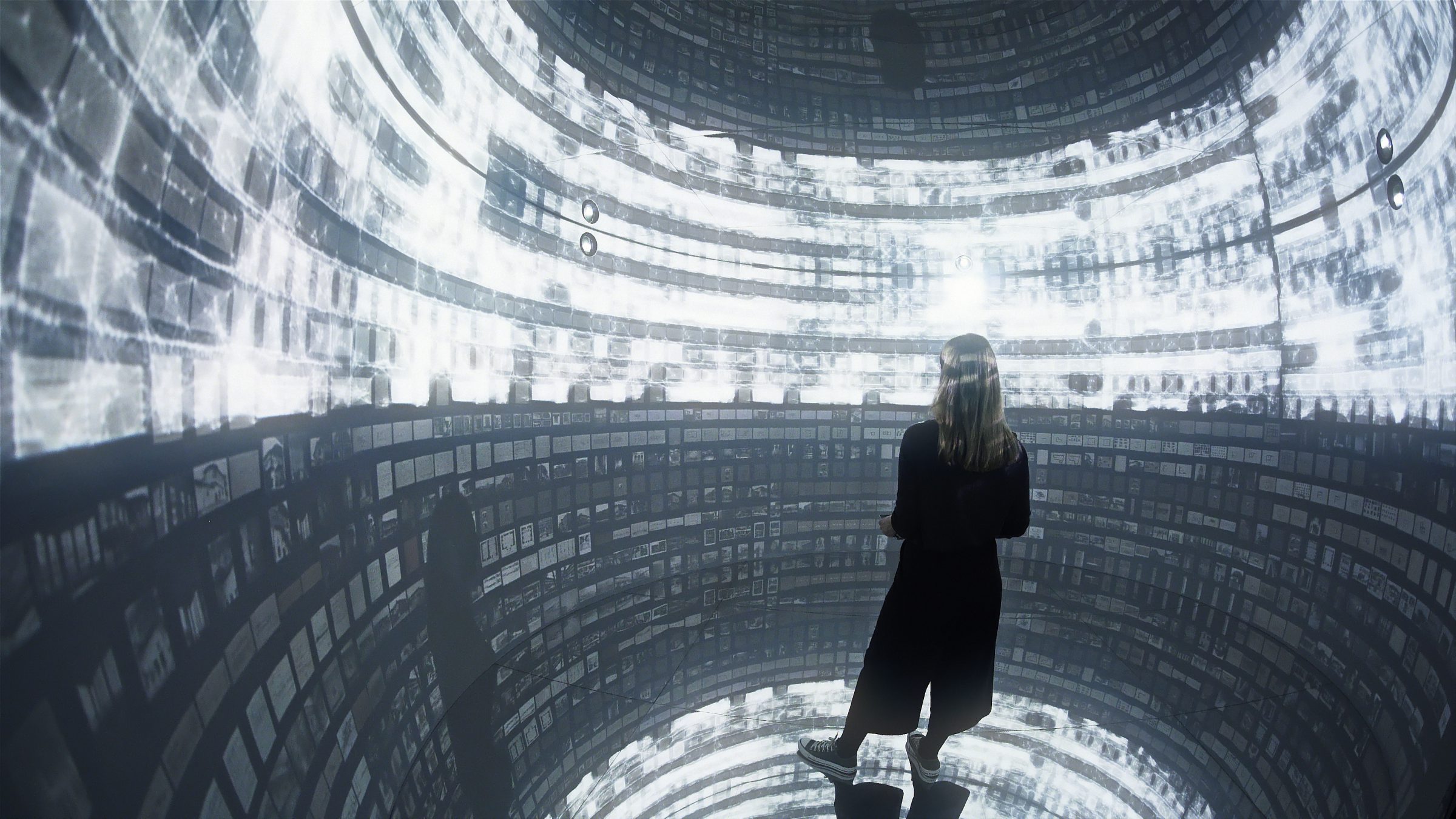
Refik Anadol, WDCH Dreams, Archive Dreaming
Public Art - Installation
San Francisco, US 02/03/2017 – 04/10/2017 / Istanbul, TR 04/20/2017 – 07/11/2017
6 Meters Wide Circular Architectural
Installation 4 Channel Video, 8 Channel Audio, Custom Software, Media Server, Table for UI Interaction Courtesy Refik Anadol StudioAG: You have also said that machines can make us “more sensitive”.
RA: I think a machine can make us more and more aware of our surroundings. There are people who don’t understand, for example, people with Alzheimer’s, or issues like climate change, can be helped [with machine learning.] However, while we are getting something completely valuable for humanity, we are also losing our most valuable things, such as our free will, and perhaps our consciousness, and then our memories. We are all in the same perfect problem moment that we still have a chance to speculate this, to fight [to make it better] or to just leave it.
AG: Have you thought about how your work can relate to these ideas?
RA: Pretty much all of my work is centered around these ideas. We work with data, how a space feels, it’s not hard to imagine what can happen if a building can dream, or imagining what can happen if a machine can learn or dream – to me, it is a super simple question. Especially if it happens in a library, where we learn about reality and history. Eventually what we can learn is to ask, who will define what is real? These are very fundamental questions in Archive Dreaming or Melting Memories. What will happen to our memories? Many of my artworks create these speculations. What will happen? The ramifications are always there, but I am wondering what else we can do with them. I am very hopeful, but I am still thinking that these questions need to be asked, and to be hopeful, to arrive at a “utopia”.

